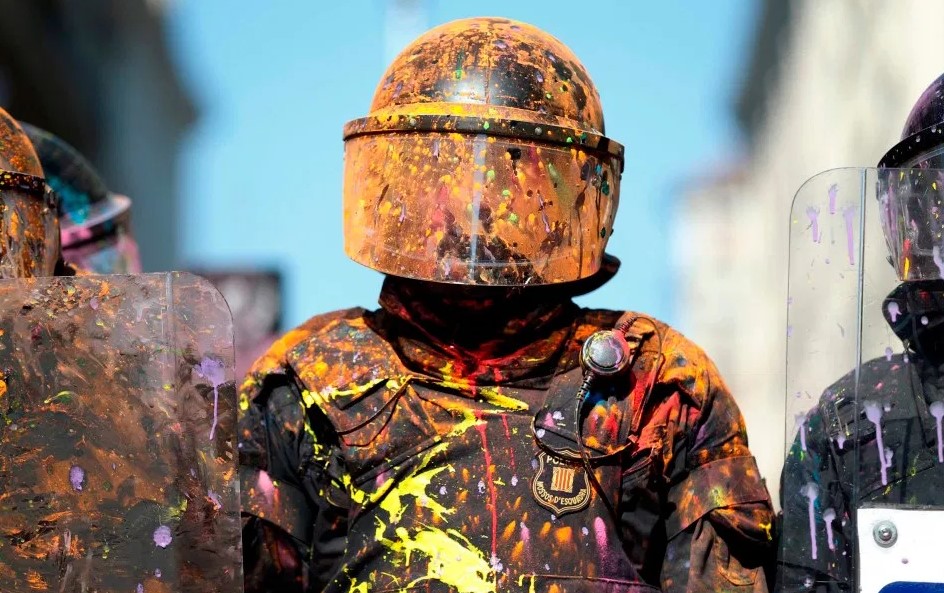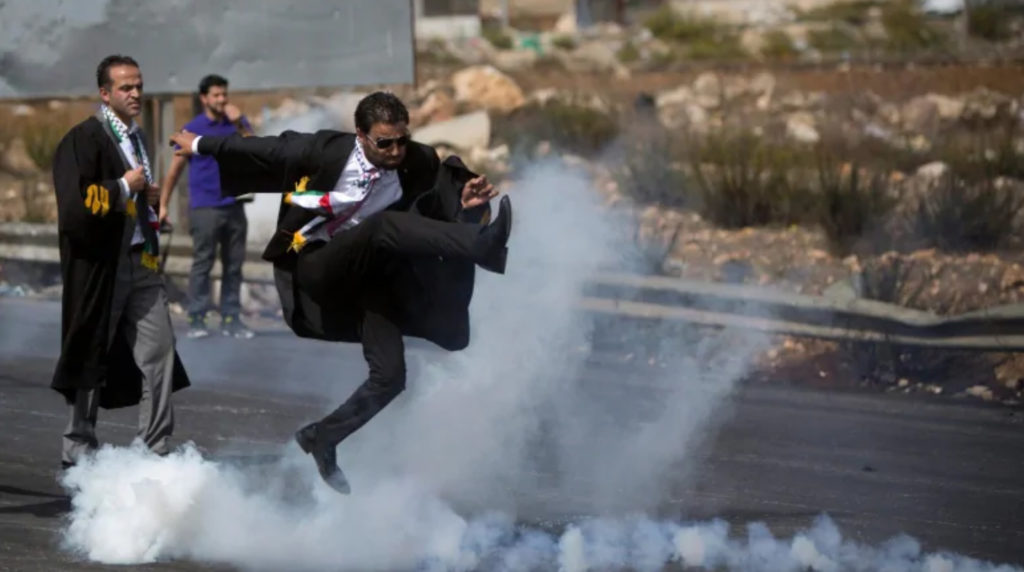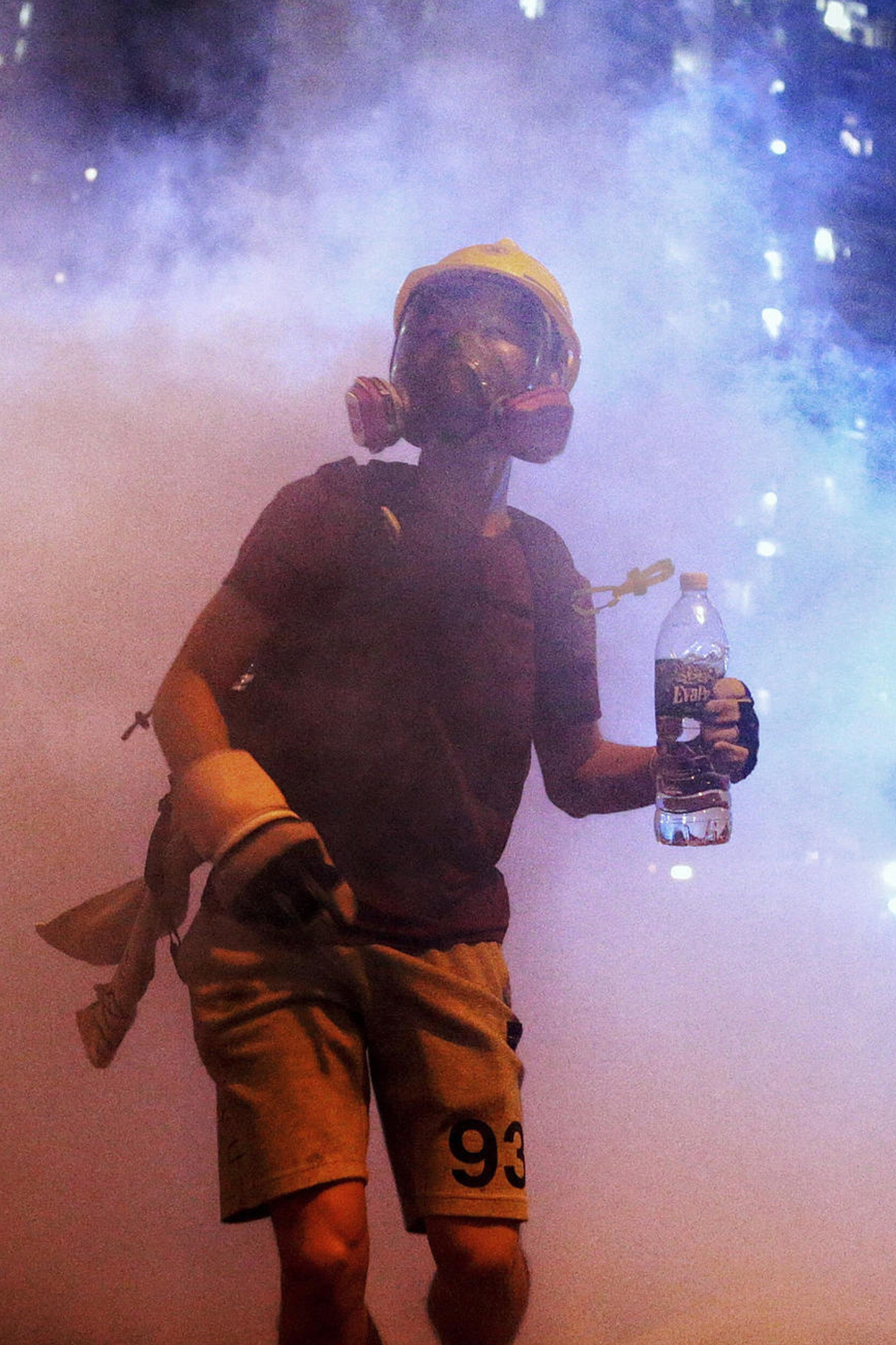Let’s be clear about this.
Tear gas is a weapon of terror which is used to intimidate and disperse.
It is neither a “none lethal” nor “less lethal” option.
“Lacrimator Agent” as they are prone to call various chemicals which the police use was developed for use in war, it’s very invention was to skirt The Hague Conventions of 1899 which restricted “projectiles filled with poison gas”. The Great War saw it’s first use to clear trenches of unfortunate working class lads in the wrong uniform and along with an array of horrific weapons it’s use in warfare was outlawed by international agreement under the Geneva Gas Protocol of 1925 which prohibits the use of “asphyxiating gas, or any other kind of gas, liquids, substances or similar materials”. It currently stands listed as part of the international trade in tools of torture by Amnesty International and yet remains a popular weapon of oppression by the majority of the worlds states.
However no one bothered to outlaw a countries use of such a horrific weapon on their own people and in the following years it became a standard tool of police to maintain order and obedience. It’s use as such first rose into the public consciousness when the Israelis used it during the first Intifada and it was discovered that the US had exported $6.5 million worth of tear-gas guns, grenades, launchers, and launching cartridges to Israel. The “less lethal” option took 40 lives during that conflict and left thousands others to suffer illness. More recently we’ve seen prodigious use on the streets of Hong Kong, Paris and Seattle to the much less documented use by U. S. Customs and Border Protection (CBP) against émigrés more than once a month since the start of the Obama administration.
It’s become a favourite of despots as gas has a psychological impact that has long been utilised to control the victims of an attack since day dot. This effect was noticed by Amos Fries of the U.S. Chemical Warfare Service who commented “It is easier for man to maintain morale in the face of bullets than in the presence of invisible gas.” A truth then as it is now a hundred years later as I was entire blocks of Seattle drowning in noxious gas. It’s use was not to clear out any violent mob, but to assault peaceful protestors, mostly teenagers. Time and time again in protest footage we see police use tear gas canisters themselves as weapons, launching them directly into peoples bodies and faces. The results, horrific. A study from Iran observed the high rate of Vascular inurioes caused by such reckless brutality from the police “with high rates of associated nerve injury (44%) and amputation (17%)” in the study.
While ostensibly a last option tool to disperse violent mobs it has overwhelmingly become the weapon of choice of law enforcements seeking to harass and stymie any assembly with a mind to protest whether radically or peacefully. It may be banned as a weapon of war but it is seeing plenty of use as a weapon of fear and control.
TACTICAL INFO
Protests can be uncompromisingly disorganised. This is especially so when is has come together as a peaceful protest and the police have decided to turn it into a riot either by pushing tensions higher or simply by straight up attacking people. The best defence against the use of tear gas in this situation as it is in more conflict prone campaigns is the prepared comrades and autonomous affinity groups who are ready to deal with this specific threat.
One of the indirect defensive tools you have is fire. While not particularly great for the environment burn bins and tires create smoke, and specifically heavy smoke. This acts as a barrier for teargas, meaning that you can block it from going towards the demo/rioters/you name it. If able you will want to ensure that the cops will not use teargas in the first place and the best method here is to to disable their masks.
In Greece, they do this by spraying lines of cops with powdered fire extinguisher, which cloggs up their gas masks and makes them think twice before using it. In Catalan protestors covered the police in paint. This can be used to reduce visibility of gas masks and riot helmet alike and if it’s a weapon being used they are less likely to deploy tear gas as it will mean they could be trapped with zero visibility. Effective ways to do this are with water bombs filled with paint solutions, or even water guns or garden spraying equipment. Make sure to use none toxic paint tho, for legal and environmental concerns.

If you are partaking in unrest where you know the police are liable to use chemical agents consider volunteering yourselves to be “gas response”. That is, protestors who are armed with devices to cover tear gas canisters and drown them in water. They is best done in teams of three or four. You’ll need someone to hold the container and someone to pour the water with preferably a couple of friends dedicating their energy to locating canisters and spotting police about to fire them. Ideally you want to respond immediately and minimise the spread and the effect on others. You will need respirators or at the very least masks,goggles and good thick gloves. Cannisters can be hot and will burn you.
The basic methodology is to quickly cover the canister and pour water all over it. A popular container is a traffic cone or for the prepared the top half of a plastic milk container. However the former is very water inefficient and the later can be quite fiddly, especially in the heat of the moment. It you have the resources and want to come prepared consider using the Printable “Anti Gas Kettle” as developed by Corgian which solves both issues at the expensive of a sizeable printing project. Download the files here on sketchfab.
Corgian asks that anyone looking to provide some material support do so to FOR THE GWORLS who helps black trans women get reaffrimative surgery as well as help them pay rent.
If you are operating solo you’ll was a water battle with a wide opening and put the tear gas cannisters inside preferably using tongs of fire retardant gloves.
Either way you’ll want several bottles of water ready to go (preferably with a good source nearby to top up) and a separate water proof bag with water in for collecting empty cannisters.
If you’re not able to dowse cannisters you can always remove the immediately threat by returning to sender. Either quickly grab the canisters and chuck them back – not very safe mind and use gloves! Heck if you’re sporting go Greek and get in some tennis practice by bringing along a racket or just be give it a good punt like this Palestinian lawyer…

MEDICAL INFO
If you are attending an action where you think you are likely to be attacking with chemical agents consider doing some prep the day before. Respirators which cover the eyes are a must, any Charcoal lines filter will do the job Tho ideally you’d have one rated to FFP2 (N95). If you shave your hair, do so the day before to allow micro-cuts to heal. If you have signicant facial hair, consider cutting it down or shaving it o to help your respirator achieve a better seal. There is a reason the army are limited to moustaches and this is it.
Before going out for an event where you expect teargas you should shower, and then do not apply makeup or other greasy stuff to your skin (like moisturisers etc) Teargas binds with grease so it is a fucker if you come to riots well-moisturised and with makeup.
Especially makeup is bad, as people tend to apply it to sensitive areas such as eyes
There are an array of compounds and blends used to the similar effect. the two primary agents are CN (phenacyl chloride or chloroacetophenone) and CS (2-chlorobenzalmalononitrile) tho notable amongst the rest are CR (dibenzoxazepine) and DM (diphenylaminechlorarsine)
Exploding tear gas grenades as well as launched cannisters that are improperly or maliciously red can cause injuries beyond the intended chemical irritation. Patients struck by cannisters may have thermal burns, contusions, bone fractures, lacerations, avulsion, amputations, or concussions. A hit to the torso, neck, or head can kill a protester.
CS is the most commonly used tear gas. Because it is so common, the literature that discusses the effects of different tear gasses typical does so by comparing their effects to CS. CN, also known as mace, is less common as it is more toxic than CS gas. CR is less toxic than CS
but a stronger irritant. CR can be identified by its pale, yellow colour and pepper-like odour. Patients whose skin is contaminated with CR may experience severe pain when wet, either during decontamination with water or due to sweating. DM is also known as adamsite and “green gas” due to its noticeable green colour. DM’s effects are similar to that of CS. The onset of symptoms is slower, but the duration of symptoms is longer, sometimes lasting over 12 hours.
CS, CN, CR, and DM are not actually gasses. They are aerosols (a suspension of fine particles in a secondary gas). They are distributed by dissolving them in a solvent, evaporating them through thermal reaction, or turning them into a micro-powder.
Symptoms of exposure to all tear gasses are generally similar. Under low concentrations, tear gas causes a burning sensation in mucous membranes, especially the eyes. Other effects are tearing of the eyes, increase nasal mucus production, and coughing. Moderate concentrations and longer exposure lead to profuse coughing, blepharospasm (involuntary closing of the eyelid), increased salivation, difficulty breathing (dyspnoea), prostration (doubling over), burning and stinging sensations on the skin, disorientation, dizziness, syncope (fainting), headache, tachycardia, and vomiting. Heavy concentrations, especially in enclosed spaces, can lead to death by asphyxiation or pulmonary edema. Patients with pre-existing respiratory disorders such as asthma are more sensitive to tear gas and exposure to even small quantities can be life-threatening.
TREATMENT BASICS
The following steps should be followed for treating patients exposed to “Riot Control Agents” or RCAs.
Introduce yourself to the patient. The patient may be blinded or disoriented, so will need to clearly introduce yourself before touching and treating them. This is true in general, but doubly so when they are alert but incapacitated. Failure to do so can lead to them striking out at you.
Remove the patient from the RCA. Pepper spray is short range and exposure happens during brief usage, but tear gas often makes air noxious for many minutes. Patients need to be moved away from tear gas before treatment can begin. Attempt to move the patient upwind from clouds of tear gas or burning cannisters. Tear gas is heavier than air, so if possible, move your patient to higher ground. In urban settings, you may be able to enter the foyer or courtyard of an apartment or building where the air is fresher.
Remove contact lenses. If the patient has RCA on their face or eyes, they should remove their contact lenses. Flushing the eyes can push contact lenses up into the eye socket. Ask your patient if they are wearing contact lenses, and if so, direct the patient to remove them before treatment. If the patient cannot open their eyes or is incapable of removing the contacts, you may need to flush their eyes until they can open them to remove the contacts. Some patients will attempt to save their contact lenses and reinsert them after you have decontaminated their eyes. You should advise them against putting the contacts back in and suggest they dispose of them immediately. However, they may have significantly impaired vision without lenses and will not be able to get home or continue participating in the action without their contacts. They may also have financial restrictions and not want to dispose of a new pair of lenses. Whatever the case may be, they may put the contacts in regardless of what you say, so your job is to help minimize recontamination and associated pain. After treatment, assist the patient with cleaning their lenses. Have them wash their hands using the solution from your bottle. Then, have them them rub their contacts together between their finger and thumb as your slowly stream water onto the lenses for at least 30 seconds. This will help remove a majority of the RCA before they put their lenses back in. After they put their lenses back in their eyes, you may need to help them gently flush out residual RCA.
Prevent the patient from touching the effected area. A patient’s instinct will be to rub the effected body part, especially the eyes and face, while contaminated and after decontamination. This can make the contamination worse and spread it to other body parts. When RCAs are deployed, no one should touch their eyes at all except to remove contact lenses.
Allow tear and mucus production. If water or saline are not available, natural tear and mucus production will eventually remove the RCA. RCA on the skin breaks down and washes o over time. Even without intervention, patients will recover, albeit much more slowly. Remove contaminated clothing. If the patient is heavily contaminated with pepper spray or tear gas, they may need to remove their clothes to prevent continued irritation. Masks and bandannas need to be removed before decontaminating the face, but other clothing can be removed after.
Decontaminate the body part. If the RCA is CR, attempt to brush and dust o as much RCA as possible. Avoid use of water or other liquids to decontaminate the patient unless they are already wet or sweaty, or the RCA is in their eyes (which are already wet). For other RCAs, flush the body part with large amounts of water. For parts of the body other than the eyes, spraying large amounts of water on the effected body part is sufficient. Specifics techniques for decontaminating the eyes are covered later in this chapter. Because pepper spray is oily, it may be useful to gently dab or wipe the effected area with gauze to remove the bulk of the pepper spray. Vigorously rubbing and scrubbing will exacerbate the pain. During treatment for both pepper spray and tear gas, attempt to prevent run off from spreading the RCA to other parts of the patient’s body or your body, especially mucous membranes or open wounds.
Rinse the patient’s mouth. Patients should rinse their mouth with water or saline to remove the RCA. Even in the absence of burning or irritating sensations in the mouth, a mouth rinse is encouraged as it helps remove the taste and it helps them feel cleansed.
Allow coughing and sneezing. If your patient is coughing or sneezing, allow them to continue as this is the body’s natural response and it will help remove the RCA. Give your patient tissue or gauze, and have them blow their nose.
Use refrigerant spray. For patients who have been contaminated with pepper spray, spray the effected areas with refrigerant spray. Use of refrigerant spray does not have an effect on pain levels beyond the immediate treatment, but it psychologically helps patients feel treated. Spray the effected areas for 3 to 5 seconds. Beware the refrigerant spray with cause a burning sensation on open wounds an mucous membranes. If the patient’s face was contaminated, instruct them to close their eyes and mouth and exhale slowly through their nose while your spray them. Consider use of an inhaler. If your patient is asthmatic, remind them to use their inhaler. If you carry a Salbutamol inhaler in your medic kit, consider suggesting they use it to self-medicate.
Consider treating for hypothermia. Patients may remove contaminated clothing, and clothing may be wet from treatment. On cool or breezy days, this can contribute to hypothermia. Consider wrapping the patient in an emergency blanket so they do not have to put back on their contaminated clothes.
Consider other complications. Patients may appear to be generally fine when you begin treatment, but you should still pay attention to their respiratory rate and overall complexion as you treat them. Patients may develop delayed respiratory distress or hyperventilation, or they may go into shock as their adrenaline wears off.
Instruct the patient on how to decontaminate at home. When you discharge the patient, direct them on how to safely decontaminate when they get home. Clothing should be removed before entering their home. Tear gas residue, especially CR, should be vacuumed o clothing and the body before entering the home. If it is available, an ultra-low particulate air (ULPA) or high efficiency particulate air (HEPA) vacuum should be used to suck up as much tear gas residue as possible. The patient should throw out the vacuum bag after use to prevent spreading tear gas. Clothing should be washed separately from other items, twice, and with a harsh detergent. If clothing cannot be immediately washed, direct them to put it into a sealed plastic bag until they can wash it. The patient should shower in a well ventilated room using the coldest water possible for at least 20 minutes. Warm water opens pores and may cause additional burning sensations, so patients should shower with the coldest water they can tolerate until the feeling of burning stops. Likewise, scrubbing effected areas should be avoided until burning stops.
For further information download Riot Medicine here.
It’s worth adding that several solutions have been developed, some of these such as Viniger or Baby Shampoo solutions are dubious and there is little reason to think they are effective and may act as an irritant themselves. Comrades in Greece however have long used milk of magnesia, specifically Maalox brand but any will do. ■

